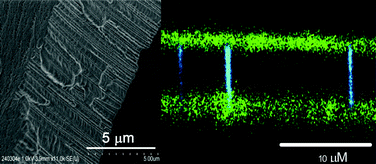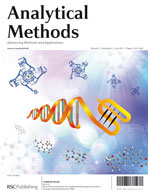Functionalized nanoporous track-etched β-PVDF membrane electrodes for lead(ii) determination by square wave anodic stripping voltammetry
Abstract
Track-etched functionalized nanoporous β-PVDF membrane electrodes, or functionalized membrane electrodes (FMEs), are electrodes made from track-etched, poly(acrylic acid) (PAA) functionalized nanoporous β-poly(vinylidene fluoride) (β-PVDF) membranes with thin porous Au films sputtered on each side as electrodes. In order to form the β-PVDF nanoporous membranes, β-PVDF films are irradiated by swift heavy ions. After irradiation, radical tracks are left in the membranes. Etching removes some of the radical tracks revealing nanopores. The remaining radicals initiate radio grafting of PAA from the pore walls of the nanoporous β-PVDF. PAA is a


 Please wait while we load your content...
Please wait while we load your content...